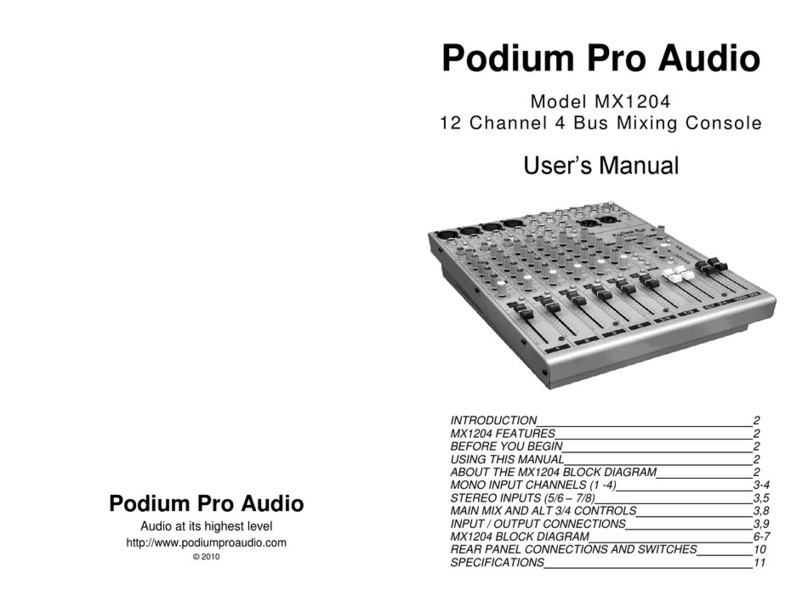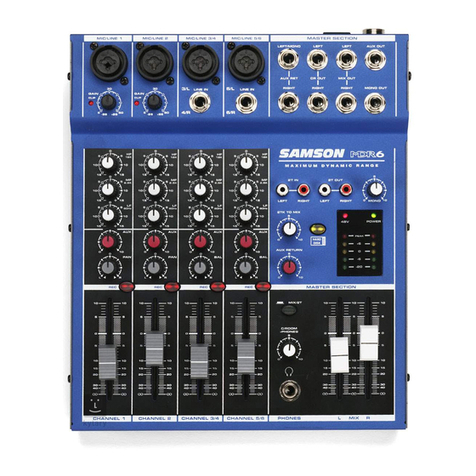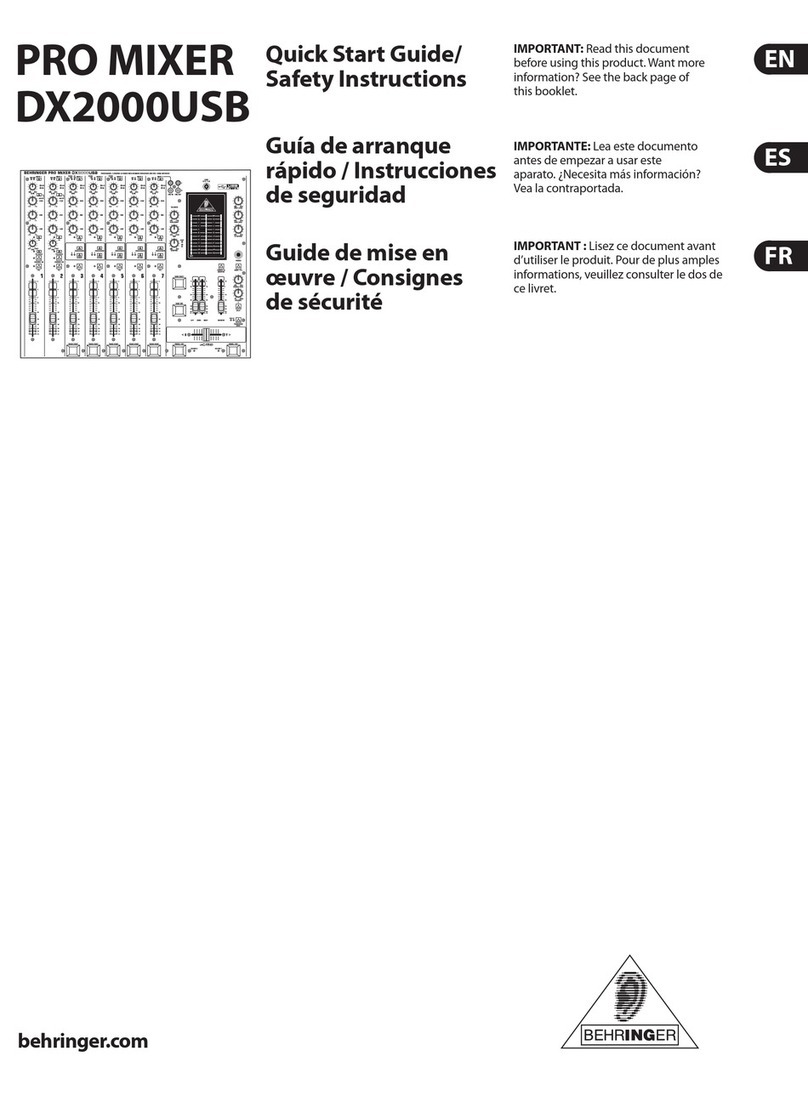SignVideo ENG-44 User manual

1 Version 3.0
SignVideo
ENG-44
Field Portable Audio Mixer
Operator's Manual
SignVideo - 1226 SE Gideon Street - Portland, Oregon 97202
503.236.0000 www.signvideo.com

2 Version 3.0
Safety Warning
Protect your ears. Always turn down the headphone volume before you connect your headphones and before you put
on your headphones. When using the headphones, set headphone volume to the lowest practical level to guard
against sudden loud noises or other changes in the sound level of the audio environment. Excessive headphone
volume may be damaging to your hearing.
Read this manual in its entirety before using or operating this product.
© Copyright 2006 by Sign Video Ltd.
ONE YEAR LIMITED WARRANTY
Sign Video Ltd. warrants this product (including accompanying accessories) and all parts thereof, except as set forth below, for a period of one year from the
original date of purchase. Should the product be found to be defective, Sign Video Ltd. will repair or replace the product at no charge.
To obtain warranty service telephone one of the numbers below or log on www.sil!nvideo.com to obtain the current telephone number for warranty repair.
The duration of any implied warranties is limited to the duration of the express warranty herein. This warranty does not cover cosmetic damage or damage
due to acts of god, accident, misuse, abuse, alteration, negligence, improper installation, tampering, criminal acts, negligence. lack of reasonable care, or if
serviced or repaired by anyone other than Sign Video Ltd. or a repair facility authorized by Sign Video Ltd.
Sign Video Ltd. shall not be liable for any loss of use, or incidental or consequential damages resulting from the use of this product orthe failure or
inoperability of this product in any respect, including from any cause whatsoever, or from breach of any express or implied warranty. In no event shall Sign
Video Ltd. be liable for any amount in excess of the purchase price paid for the product, except to the extent prohibited by applicable law.
Some slates do not allow the exclusion or limitation of incidental or consequential damages, or permit limitations on how long an implied warranty lasts, so
these exclusions and limitations may not apply to you. This warranty gives you specific legal rights and you may also have other rights which vary from state
to state.
Sign Video Ltd.
(800) 373-8910
(503) 236-0000
www.signvideo.com

3 Version 3.0
Note: This equipment has been tested and found to comply with the limits for a Class B digital device, pursuant to
part
15
of the FCC Rules. These limits are designed to provide reasonable protection against harmful interference in a
residential installation. This equipment generates, uses and can radiate radio frequency energy and, if not installed and
used in accordance with the instructions, may cause harmful interference to radio communications. However, there is
no guarantee that interference will not occur in a particular installation. If this equipment does cause harmful
interference to radio or television reception, which can be determined by turning the equipment off and on, the user is
encouraged to try to correct the interference by one or more of the following measures:
•Reorient or relocate the receiving antenna
•Increase the separation between the equipment and receiver
•Connect the equipment into an outlet on a circuit different from that to which the receiver is connected
•Consult the dealer or an experienced radio/TV technician for help
Note also that changes or modifications to this equipment not expressly approved by Sign Video Ltd. could void your
legal authority to operate this equipment.
This Class B digital apparatus complies with Canadian ICES-003.
Cet appareil numériqué de la classe B est conforme à
la norme NMB-003 du Canada.

4 Version 3.0
Front Panel
1. CH1-CH4 Gain Controls Individual gain controls for each of the four input audio channels, marked 1-4. Gain
controls are also known as faders or level controls.
2. Master Gain Control Controls overall gain and volume of the Reference Tone.
3. FLAT/Low Cut Filter Switches Switches for each of the four input channels select between flat (no filter) and
100 Hz roll off (attenuates audio in frequencies below 100 Hz). Use to reduce wind noise or other low frequency
noise.
4. Pan Selectors Slide switches for each of the four input channels assign each input to either the left, right or both
audio channels. (Select C position for both channels to place the audio in the center).
5. LED Audio VU Meter Two rows of LEDs light in progression to indicate peak level on the right and left audio
channels. The meter has a VU scale, however the meter ballistics are those of an instantaneous peak reading
meter. The VU METER INTENSITY switch on the Underside Panel may be switched to HIGH for high visibility
when outdoors or may be switched to LOW to conserve battery power.
6. Other LED Indicators
LIM Output Limiter Lights when the limiter is triggered by audio levels just below the preset
threshold of +4 dBu.
EXT Power Lights automatically when external power is being used.
BAT Power Lights automatically when battery power is being used.
Low Battery Warning BAT flashes when the battery needs to be replaced. Prior to this, BAT will flash
only on audio peaks as an early warning.
NOTE: The unit is reverse voltage protected. No permanent damage can be sustained from reverse voltage.
7. Reference Tone Switch from MIX to TONE to generate 1 kHz reference tone. The Master Gain Control varies
the output level of the reference tone. When it is set to 0 VU, an output of -4 dBu (0.489 Vrms) is sent to the XLR
Outputs (when LINE level is selected on the Balanced XLR Output of the Underside Panel).
8. Slate Momentary push button activates the Slate Mic. located on front panel. Push and hold in while verbally
identifying the audio take. Release to deactivate the Slate Mic. and continue with the take.
9. Head Phone Jack 1/8" jack for operator head phone monitoring. (Note that there is a separate XLR head
phone jack for boom operator. See Right Panel.) Turn down headphone level control before connecting or putting
on headphones.
10.Head Phone Level Control Adjusts head phone volume for both mixer operator and boom mic operator.
Reduce volume before putting on headphones to protect your hearing. Use at lowest practical level to protect your
hearing.
11.Tape Return Selector Slides from MIX to TAPE RETURN to allow head phones to monitor audio from video
camera, tape recorder or other audio device.
12.Strap Ears Adjustable shoulder strap (included) attaches to these metal ears. These are removable.

5 Version 3.0
Left Panel
MIC/LINE XLR Inputs Channel 1 through 4 XLR transformer balanced audio inputs. Use individual selector
switches located on the underside panel of the unit to choose mic/line level for each input and to activate/ deactivate
+48 volt phantom power for each input. For any given input, turn off phantom power if not specifically required by the
microphone in use (using the switch on the underside of the unit).
These XLR connectors are wired in the following manner:
Pin 1: Ground (shield) Xternal
Pin 2: Hot (in phase) Live
Pin 3: Cold (out of phase) Return
Phantom power for these XLR connectors is wired in the following manner:
Pin 1: Ground
Pins 2 & 3: Carry 48 volts DC through 6.81 K resistors when the particular input is
switched to phantom power using the corresponding switch on the underside
of the product.

6 Version 3.0
Right Panel
1. Boom Head Phone Out XLR audio output for boom operator head phone monitoring. XLR output allows use of
cable with XLR connectors rather than one with 1/4" connectors. Use a 1/4"
adapter to connect to head phones.
This way your spare XLR cable also serves as your spare boom operator cable, and you only need carry a small
spare 1/4" adapter.
2. XLR Outputs 2 Balanced MIC/LINE audio outputs, selected using the MIC/LINE switch on
the Underside Panel. Use LINE level whenever possible to minimize signal noise.
3. Line Out Line level 3.5 mm (1/8") unbalanced audio output jack. Can be used to feed
audio to cameras that only provide a 3.5 mm audio input jack. This is not recommended
when using cables longer than a few feet. For longer cables runs to camera see the Using
an XLR-Pro ™ Adapter section of this manual.
4. Mic Out Microphone level 3.5 mm (1/8") unbalanced audio output jack. Can be used to
feed audio to cameras that only provide a mic level 3.5 mm audio input jack. This is not recommended when using
cables longer than a few feet. For longer cables runs to camera see the Using an XLR-Pro™ Adapter section of
this manual.
5. Auxiliary In 3.5 mm (1/8") unbalanced audio input jack
6. Tape Return In 3.5mm (1/8") unbalanced audio input jack for connection to a video camera, tape recorder or
other audio device. This is usually used to feed back the recorded audio signal for monitoring on headphones.
7. Power on/off Switch

7 Version 3.0
Rear Panel
1. External Power 2.1 mm ID x 5.5mm OD external power jack. While this unit can operate fully on battery power,
this input allows the unit to also be powered from a wall power outlet by using the AC power adapter that is
supplied with the unit. Plug the AC power adapter itself into the wall outlet, then connect the AC adapter's low
voltage DC output cord to this Input jack. Note that power automatically switches to external when external power
is supplied, and back to battery when external power is removed.
2. Battery Compartment Slide out drawer holds four AA batteries.

8 Version 3.0
Underside Panel
1. MIC/LINE Input Switches Individual switches for each input channel select between mic and line level in. One
switch for both XLR outputs switches between mic and line level out.
2. Phantom Power Switches Individual switches for each input channel activate/deactivate +48 Volt phantom
power. Some microphones require phantom power to operate. However, do not apply phantom power except for
microphones that are equipped to operate on phantom power. Check the microphone operating manual if you are
not certain. For phantom power XLR connector wiring, see Right Panel section of this manual.
3. VU Meter Intensity Switch Controls brightness of VU meter LED display located on the front panel. Select
HIGH for high visibility outdoors,. Select LOW to conserve battery.
4. Tape Return Level Control Adjustable amplifiers allow matching to the vast majority of video cameras and
other recording equipment for monitoring tape confidence heads. Use a small flat blade or Phillips screwdriver to
adjust the level for the best match. Many consumer/prosumer DV camcorders may not provide tape confidence
heads. However, tape return is still valuable for checking for bad cable connections etc.
5. Balanced XLR Output Level Switch (not shown in the photo above) Switches the XLR Outputs between
MIC and LINE levels.
6. Feet These are supplied to protect the unit from wear for table top use. If you wish to remove the feet, it is okay to
remove the feet and reinstall the existing screws. While they will screw further into the unit without the feet, they will
not damage anything.

9 Version 3.0
ENG-44 Specifications
Country of Manufacture: USA
Input Impedance: 2K, transformer balanced
Output Impedance: 600 Ohms (both balanced and unbalanced line level outputs)
Frequency Response: 20Hz to 20kHz +/-
1.5 dB
Distortion: < 0.1 % (1 kHz
@
0 dBu output)
Noise: -126dBu EIN
Overall Gain: 66 dB
Output Limiting level: +4 dBu
Low Cut Filters: 100 Hz, -6db/octave roll off
Tone Oscillator: 1 kHz,
+/-
5%, <0.2% THD (@ 0 dBu)
Aux Input: unbalanced line level, input impedance of 47 kOhms, AC coupled, via stereo 1/8" (3.5mm) jack
Tape Return: input impedance 10 kOhms, Left/Right input levels independently adjustable
Headphone Output: 10 Ohms output impedance
Phantom Power: +48 VDC "48 PH", individually switchable, 14mA maximum (total of all microphones)
Battery Life: 14 hours normal mixer operation
Internal Power: 4 x "AA" batteries; Alkaline (recommended) or rechargeable NiMH (charging unit not included)
External Power: 9-18 VDC via 2.1 x 5.5mm coaxial power plug; center positive; input protected against reversed polarity
Size: 1.5"x1 0.5"x6.5" (HxWxD), exclusive at detachable strap "ears"
Weight: 2.25 Ibs (1.0kg) with alkaline batteries

10 Version 3.0
Using an XLR-Pro
™
Adapter
Many consumer/prosumer camcorders only offer an unbalanced 3.5mm
(1/8")
audio input. While you can connect directly to
this input from the mixer using the mixer's 3.5mm unbalanced audio output jack, this is not recommended for cable runs
longer than a few feet. This is because long unbalanced audio lines tend to pick up noise. The longer the line, the worse the
problem may be. To avoid this problem, you can purchase a SignVideo XLR-Pro
™
Audio Adapter and connect it to your
camcorder. Then you can feed a balanced audio signal from the XLR outputs of the mixer to the XLR inputs of the XLR-Pro
™
and use as long a cable as you need. The XLR-Pro
™
provides an output cable with 3.5mm stereo jack that can be directly
connected to the camcorder.
Installing the Optional Soft Field Case
An inexpensive ($49.95) soft field case is available for the ENG 44 Mixer.
To attach the case, first place the velcro support belt around the mixer chassis. Align the strap loops to
coincide with the strap wings on the mixer. Undo the shoulder strap, and insert each end thru both the mixer’s metalstrap
wing and the loops on the velcro belt.
Table of contents
Other SignVideo Music Mixer manuals
Popular Music Mixer manuals by other brands
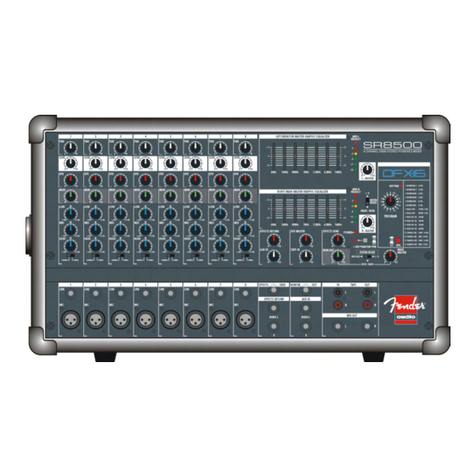
Fender
Fender PASSPORT SR6300 Service manual

Tascam
Tascam DM-24 Installation information
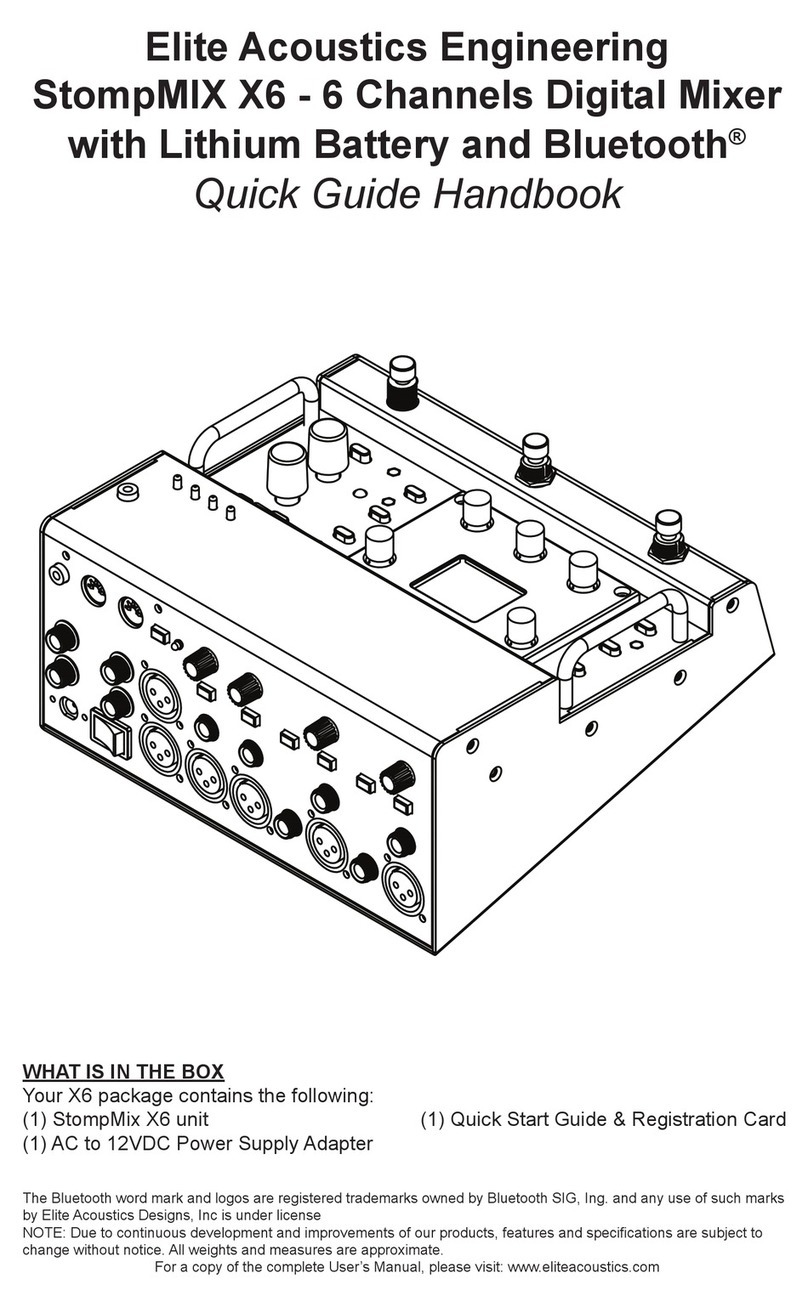
Elite Acoustics Engineering
Elite Acoustics Engineering StompMIX X6 quick guide
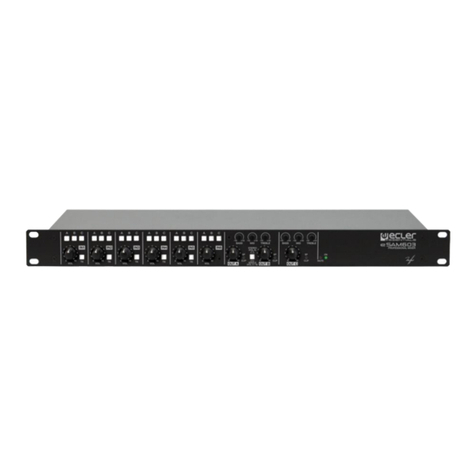
Ecler essentials
Ecler essentials eSAM603 user manual
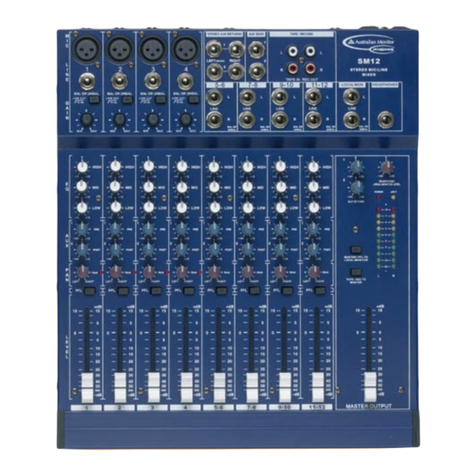
AUSTRALIAN MONITOR
AUSTRALIAN MONITOR SM12 brochure
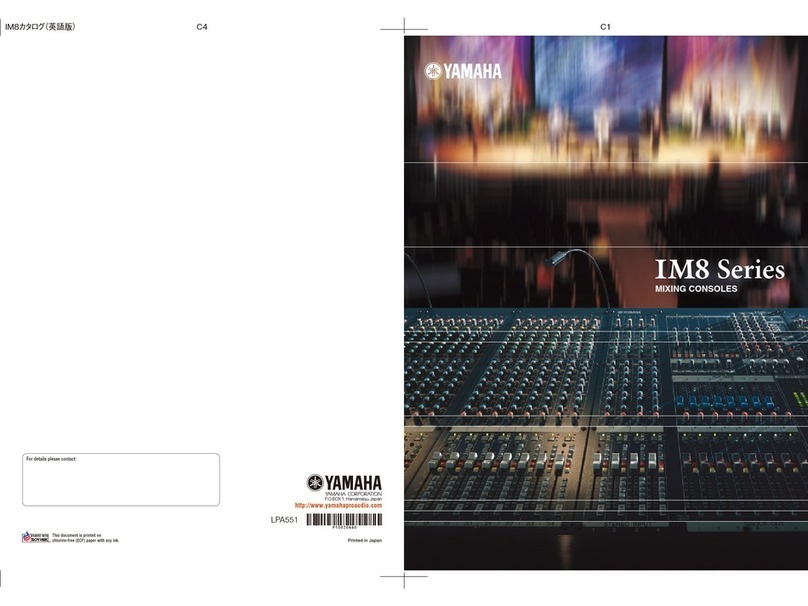
Yamaha
Yamaha IM8-40 Brochure & specs






